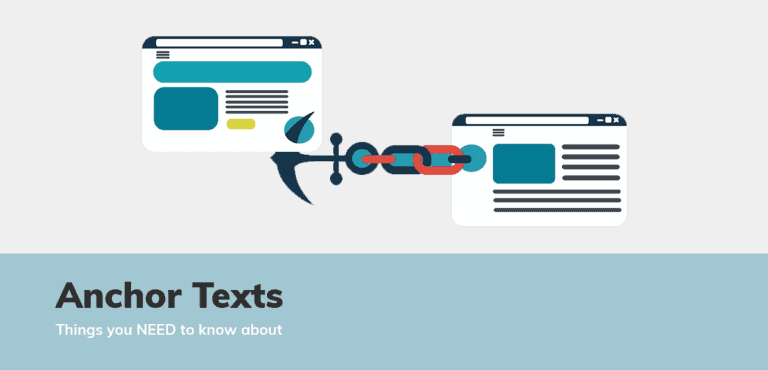When building links, many SEOs like to send the exact match anchor text back to their websites. Although it may improve your website rankings, it’ll actually do you more harm than good.
Before I breakdown the different types of anchor texts, let me first explain what are anchor texts.
What are anchor texts?
Anchor texts are the clickable words/phrases that you see on a website. When you click on it, it will either lead you to other pages within the same website (internal anchors), or to other websites (external anchors).
The different types of anchor texts?
There are many names for the different anchor texts you can find online. Most of them refer to the same thing, with slight variations. Here is how I categorise anchor texts:
- Branded anchor: An anchor text that uses the company or website’s brand.
- E.g. <Firdaus Syazwani> is an SEO specialist in Singapore.
- Naked URL: An anchor text that uses the website’s URL.
- E.g. <firdaussyazwani.com> is an SEO specialist in Singapore.
- Partial match anchor: An anchor text that uses part of the keyword you’re trying to rank for.
- E.g. Firdaus Syazwani <is an SEO specialist> in Singapore.
- Exact match anchor: An anchor text that uses the exact keyword you’re trying to rank for.
- E.g. Firdaus Syazwani is an <SEO specialist in Singapore>.
- Miscellaneous anchor: An anchor text that does not fall in any of the above types.
- E.g. Firdaus Syazwani is an SEO specialist in Singapore. <Read more about him here>.
Although I categorise these anchors as such, it is possible to receive anchors that are a combination of the above. For example, a branded and partial match anchor could look like this: <Firdaus Syazwani is an SEO specialist> in Singapore.
For such combinations, my rule of thumb is that if the anchor text contains ANY of your keywords, I’d label it as a partial match anchor.
Why are anchor texts important?
Anchor texts are important as it tells search engines (and users) what the page you’re linking to is about. Usually, users will be able to roughly know what you’re linking to based on the surrounding context of the link.
For example: <Click here> to read more about on-page SEO.
As humans, you can tell that the <Click here> anchor will lead you to another page about on-page SEO.
Search engines may or may not be as smart as humans. That’s where anchor texts come into play – providing relevance and meaning to a link. Unfortunately with this, SEOs are unnaturally building links to their websites with partial/exact match anchors in hopes to game the system.
However, what most SEOs don’t know is that they’re over-optimising their anchor texts. This means that they’re sending too many anchors for the keyword that they’re trying to rank for. Doing this will almost put you at risk of the Penguin algorithm.
What you should do instead, is to observe how other webmasters link out to other websites. Have a look at a handful of websites, and you’ll find out that partial or exact match anchors don’t occur frequently.
Now that you know partial and exact match anchors don’t occur frequently, you will need build links that look “natural”. Diversify your anchor texts by mixing around the different anchor types, and lower the risk of any penalties.
How do I make my incoming anchor texts look natural?
It is first important to note that anchor texts are calculated on a per page basis, not sitewide. Therefore when deciding on the ratio you should take, you’ll have to calculate it page by page.
The best way to do it is to use Ahrefs or SEMrush to analyse the competitors’ anchor texts. This will provide you with an accurate representation of how you should replicate it for yourself.
However, if you don’t have the budget, what I like to do to keep myself safe is to use the below ratios:
- Branded anchor: ~70%
- Naked URL: ~20%
- Partial match anchor: 1-5%
- Exact match anchor: Less than 1%
- Miscellaneous anchor: ~5%
If you have control over your anchors, I like to follow the above. These numbers aren’t absolute, so if you don’t have full control, feel free to play around with anchor types 1,2, and 5.
The branded, naked URL, and misc anchors have more leeway as webmasters are more likely to link to you using these types of anchors.
As mentioned previously, linking with partial and exact match anchors are highly unlikely, and that’s why you should keep them low. This keeps your incoming anchor text profile looking clean and natural.
What about internal anchor texts?
In Google’s eyes, you have control over your internal anchors. Many SEOs I follow say that you’re free to choose whatever internal anchors you want. However, I doubt that’s the case.
I believe that if over-optimising your incoming anchor texts has risks, so does internal anchors. What I also believe is that you can be more liberal with your internal anchors.
This means that you can use more partial and exact match anchors for internal links to pass relevancy to your other pages. And you definitely should do that.
Recently, thanks to Matt Diggity, I started keeping track of my internal anchors. I used more partial match, exact match, and miscellaneous anchors with less of branded and naked URLs. What I observed was interesting.
Keywords for those pages have seen improvements. But hey, it’s just an observation. It could have been other factors that affected it as it wasn’t even close to a controlled test.
Below are the approximate ratios that I used for my internal anchors:
- Branded anchor: Less than 5% (you don’t refer to yourself in third person do you?)
- Naked URL: ~5%
- Partial match anchor: ~45%
- Exact match anchor: ~30%
- Miscellaneous anchor: ~15%
Although I don’t have the exact ratios, I believe it’s pretty safe to be more aggressive with your internal anchors. I think it’s pretty normal to internally link your pages with keywords anyway.
Did this post help you? Let me know in the comments below!




